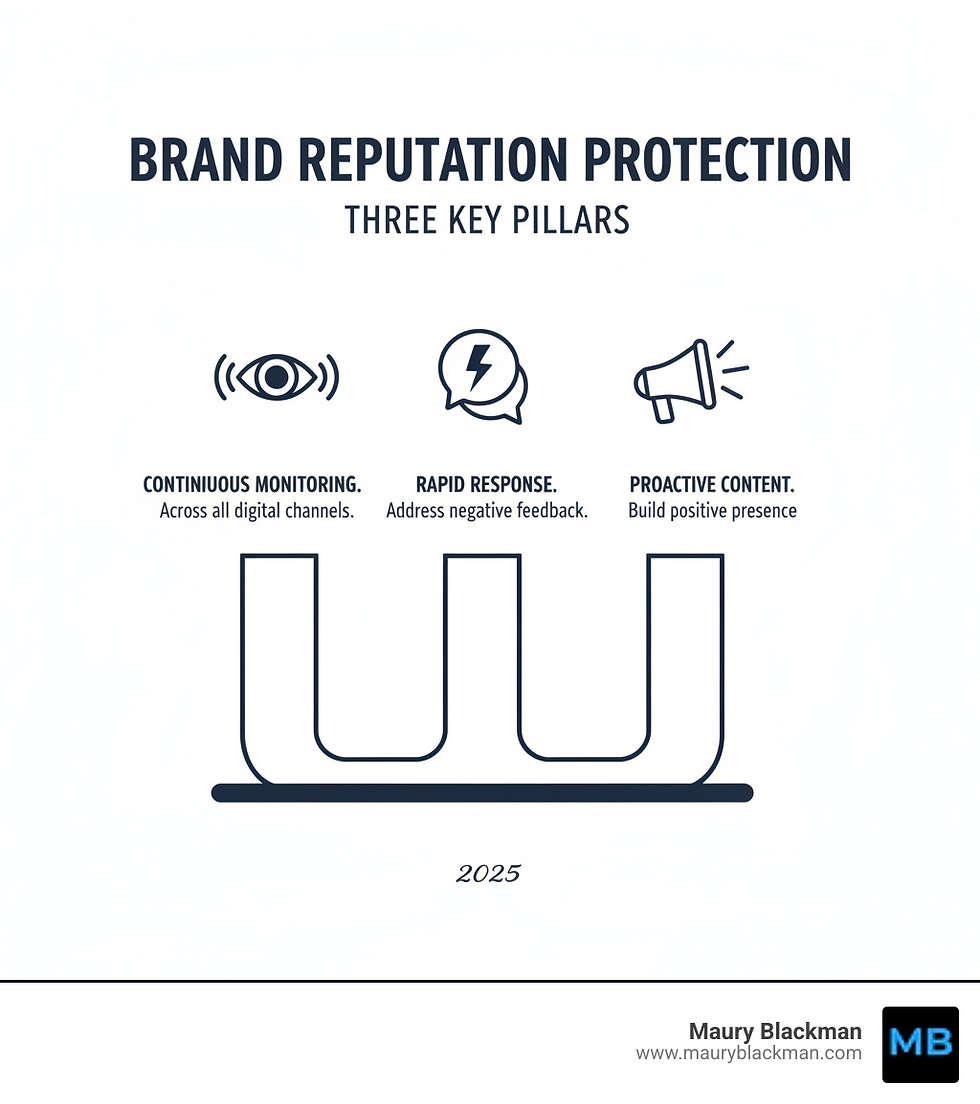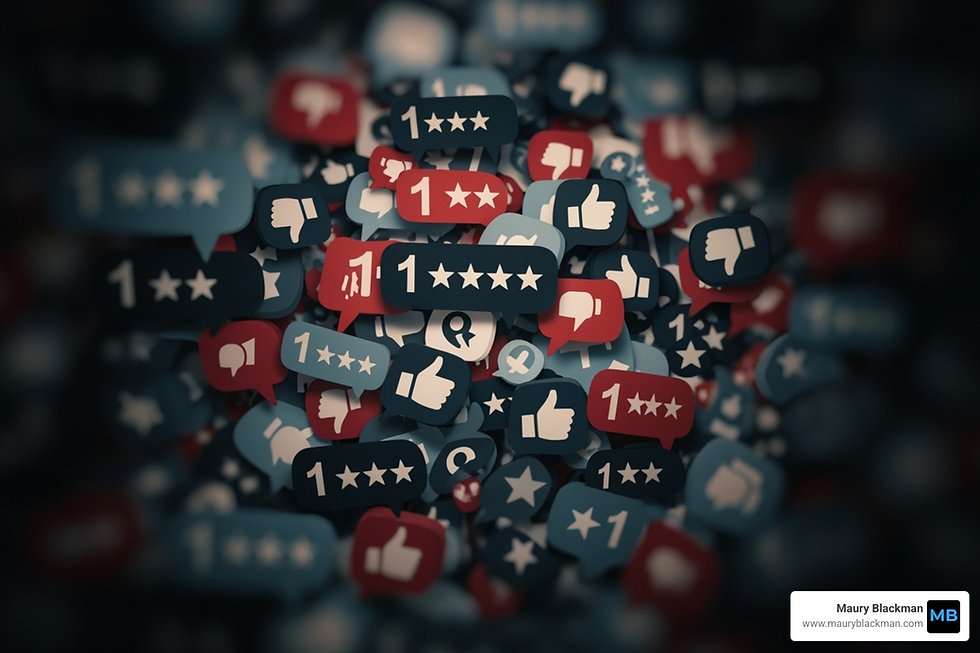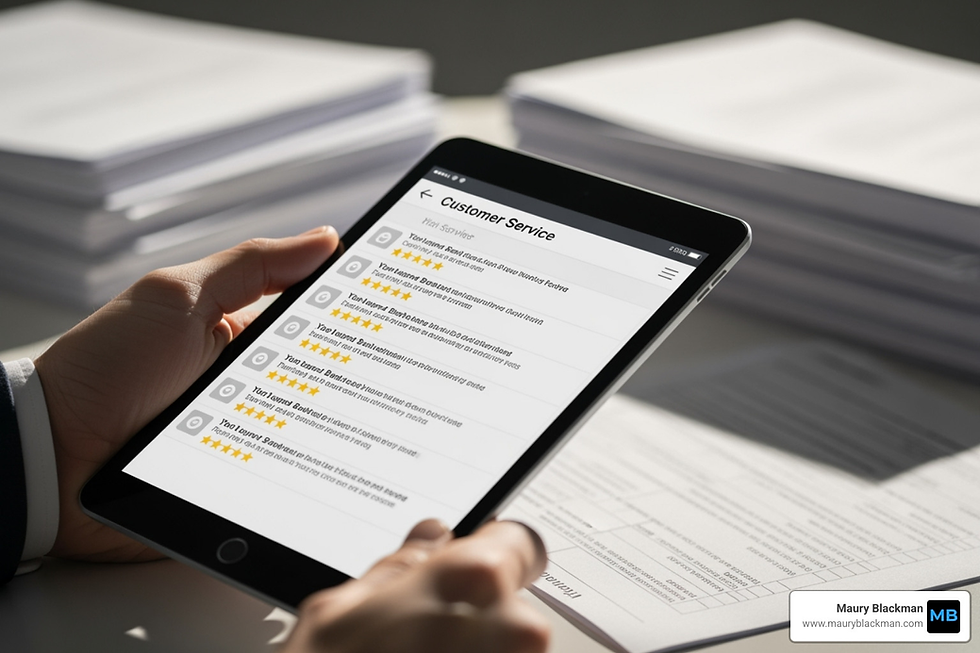Don't Let Your Brand Go Bust: Master Reputation Protection
- mauryblackman
- Sep 20
- 9 min read
Why Your Brand's Reputation is Your Most Valuable Asset

Brand reputation protection is your shield against digital threats. In today's hyper-connected world, a single negative review, viral post, or data breach can destroy years of hard work and tank your startup's credibility overnight.
Key Brand Reputation Protection Strategies:
Monitor continuously - Track mentions across social media, review sites, forums, and news outlets
Respond quickly - Address negative feedback within hours, not days
Build proactively - Create positive content and thought leadership to strengthen your digital presence
Prepare for crisis - Have a response plan ready before you need it
Leverage technology - Use AI-powered tools combined with human intelligence for comprehensive protection
The stakes are high. The online review market is valued at $500 billion, and 57% of buyers say thought leadership builds brand awareness. For startups, reputation isn't just image—it's survival.
Your reputation impacts everything from customer acquisition to investor confidence. A viral post about poor service can derail funding rounds, while competitors watch for any misstep.
Having led high-growth tech companies like Premise Data and Accela, I've seen how brand reputation protection can make or break a startup. Proactive reputation management isn't optional—it's essential for sustainable growth.

Identifying the Digital Minefield: Primary Threats to Your Brand's Reputation
The digital landscape is a minefield for your brand's reputation. Understanding the primary threats—from disgruntled customers to malicious competitors—is the first step in building your defense.

Negative reviews are an immediate threat. Since consumers rely on online ratings, a cascade of one-star reviews can be devastating. The market is also plagued by fraud. As we've explored in The High Cost of Review Fraud, fake reviews can manipulate public perception and unfairly damage businesses.
Social media crises erupt with dizzying speed. A poorly worded tweet or insensitive ad can go viral globally, turning a minor oversight into a PR nightmare. With digital chatter reaching over 4 billion people, controlling the narrative is incredibly challenging.
Misinformation and rumors erode trust. False claims about your products or business practices can spread like wildfire, especially when amplified by coordinated groups, creating a distorted brand perception.
Employee misconduct is a significant risk. A single employee's public inappropriate behavior can reflect poorly on the entire organization. This highlights the need for clear internal communication and a strong company culture where everyone helps protect the brand's reputation.
Data breaches are a catastrophic threat. They compromise customer data, shatter trust, and lead to financial penalties and customer loss. Cybersecurity is a critical component of brand reputation protection.
Unethical supply chain practices can cast a dark shadow on a brand. Media attention on poor working conditions has damaged many companies. For example, a report by The Business & Human Rights Resource Centre highlighted fashion brands’ “failure to eradicate forced labour.” Consumers and investors care about ethical issues, making transparent sourcing paramount.
Finally, competitor attacks can include fake negative reviews, cybersquatting, and phishing attempts that impersonate your brand. These acts of brand abuse aim to damage your integrity and steal customers. Protecting your brand means monitoring for these attacks and enforcing your intellectual property rights.
Building Your Fortress: A Comprehensive Brand Reputation Protection Strategy
Think of brand reputation protection as building a fortress. You don't wait for an attack to reinforce your walls. It's about building defenses to prevent disasters, not just fixing problems after they explode online.

The difference between proactive vs. reactive strategies is like a smoke detector versus the fire department. Proactive strategies help you spot trouble before it becomes a crisis, while reactive strategies mean scrambling to control damage.
An effective strategy requires a holistic approach. Reputation is everyone's responsibility, from the CEO to customer service reps. This requires a solid governance structure with executive-level ownership to ensure brand protection gets the needed resources and attention.
The magic is in integrating technology and human expertise. AI tools monitor millions of conversations, but humans understand nuance. Technology is the early warning system; human intelligence is the strategic brain. Don't forget cybersecurity measures and intellectual property protection, as every vulnerability is a reputation risk.
Step 1: Implement Proactive Online Monitoring and Social Listening
Managing your reputation without monitoring is like protecting a house without knowing who's in the neighborhood. You need eyes and ears everywhere your brand is mentioned.
Monitoring tools like Google Alerts offer basic coverage, but serious brand reputation protection requires more sophisticated tools to track sentiment and spot potential problems early.
Social listening goes deeper than counting mentions; it's about understanding the mood behind conversations. This sentiment analysis helps you gauge public opinion and spot shifts in perception.
Real-time alerts are crucial because a negative story can circle the globe instantly. The key is tracking digital chatter and keywords (your company name, products, and misspellings) across all channels.
Key areas to monitor:
Social Media Platforms (Facebook, X, LinkedIn, Instagram, TikTok)
Review Sites (Yelp, Google Reviews, industry-specific platforms)
Forums & Blogs (Reddit, Quora, industry forums, personal blogs)
News Media (online news outlets, press releases, syndicated content)
By keeping tabs on these channels, you'll know what people are saying about your brand before it becomes everyone's business.
Step 2: Analyze Customer Feedback to Fortify Your Brand
Customer feedback is a crystal ball for improving your business. The trick is to listen, even when the message is hard to hear.
Gathering feedback effectively means casting a wide net using public reviews, surveys, interviews, and focus groups to get the full story.
Review analysis reveals patterns that individual complaints might miss. The real value is identifying pain points before they become reputation killers. By spotting recurring complaints early, you can address root causes, showing customers their voices matter.
Enhancing customer experience based on feedback creates a positive loop. Happy customers become your best marketing team. Turning insights into action proves you're not just collecting feedback—you're using it to get better.
Step 3: Master the Art of Responding to Online Criticism
How you handle criticism separates professional brands from amateurs. Every negative comment is a chance to show your character and win over skeptics.
Responding promptly is non-negotiable. A quick response shows you're engaged and care. Professionalism and empathy should guide every interaction. Acknowledging the issue doesn't mean admitting fault—it means showing you take concerns seriously.
Offering solutions transforms complaints into opportunities. Sometimes the best strategy is taking conversations offline by providing a direct email or phone number to resolve the issue privately.
The goal is turning detractors into advocates. A customer whose problem is solved well can become more loyal than one who never had an issue. This principle of transparency is key, as seen when CBS Face the Nation Ends Editing of Taped Interviews, a move that strengthened public trust.
Step 4: Combine Technology with Human Intelligence for Effective Brand Reputation Protection
Relying only on technology for reputation management is like using GPS without looking out the windshield. You need both data and the wisdom to interpret it.
AI-powered monitoring and risk-sensing tools excel at processing massive amounts of information, but human analysis provides the context that machines miss. AI might flag a sarcastic joke as negative, while humans understand the nuance.
This combination creates powerful contextual understanding. AI identifies what's said; human experts determine what it means and how to act. This collaboration eliminates time-wasting false positives.
As explored in The Double-Edged Sword of AI Meeting Transcripts, technology provides incredible capabilities, but human oversight ensures ethical and contextual appropriateness. This hybrid approach has been proven effective since 2005, leveraging the best of both worlds to create a defense system that's both comprehensive and intelligent.
From Defense to Offense: Proactive Reputation Building
The best defense is a great offense. True brand reputation protection means controlling your narrative and actively shaping how the world sees your brand, rather than letting others define it.

Think of it as filling a glass with clean water before someone adds mud. When you consistently build a positive digital footprint, negative content gets diluted. A smart content strategy is the backbone, using blog posts and guides to tell your story and showcase your expertise. Search engine optimization (SEO) amplifies this effort, ensuring your content ranks first for brand-related searches.
Brand advocacy programs turn your biggest fans into your marketing team. Their authentic voices become a protective shield around your reputation.
Preparing for the Worst: Your Crisis Management Blueprint
Even brands with spotless reputations face unexpected crises. The difference between survival and failure is having a solid plan ready before you need it.
Your crisis communication plan is like a fire extinguisher. It should map out who does what when a crisis hits, ensuring clear action steps. This designated response team needs people from legal, communications, and leadership who can make decisions quickly.
Internal communication protocols keep your employees informed and prevent them from spreading misinformation. Your stakeholder engagement strategy ensures different groups get consistent, truthful messages. Pre-approved messaging templates save precious time, while post-crisis analysis helps you learn from every incident to strengthen future responses.
Shaping the Narrative: The Power of Digital PR and Thought Leadership
The most powerful brand reputation protection strategy is to be genuinely helpful. When you consistently create valuable content that solves real problems, people see you as a trusted resource, not just another company.
Establishing expertise happens one insightful article or helpful video at a time. This approach naturally builds credibility without feeling self-promotional.
The numbers tell a compelling story. Research from LinkedIn shows that 57% of buyers say thought leadership builds awareness for new brands, and 60% say it builds credibility. For newer companies, it's essential: 53% of buyers believe they must produce it to be considered. Encouragingly, four out of five buyers report that thought leadership led them to purchase from companies that weren't category leaders.
Attracting followers through valuable content creates a community of advocates around your brand. This proactive approach creates a "reputation buffer." When negative incidents occur, they're viewed against your positive presence, making people more likely to give you the benefit of the doubt.
Just as understanding broader patterns helps us steer current challenges—like those explored in From the Red Scare to the DEI Purge—building thought leadership helps your brand steer reputation challenges with greater resilience.
Frequently Asked Questions about Brand Reputation Protection
Brand reputation protection can feel overwhelming. These are the questions I hear most often from business owners who want to protect their brands but aren't sure where to start.
What is the first step in brand reputation protection?
The first step is comprehensive monitoring. You can't protect against threats you don't see. This means tracking mentions of your brand, products, and key personnel across the web—social media, review sites, news outlets, and forums. The goal is to establish a baseline of your current reputation.
This continuous monitoring is your early warning system, helping you spot issues before they become crises. Understanding public perception provides the foundation for an effective strategy.
How can a small business protect its brand reputation with a limited budget?
Effective brand reputation protection doesn't require a massive budget. Small businesses can be more agile and respond faster than larger companies.
Start with free tools like Google Alerts to track mentions. Secure your brand name on all major social media platforms, even if you don't use them yet, to prevent others from claiming your digital real estate.
The most powerful low-cost strategy is to actively encourage satisfied customers to leave positive reviews. Happy customers often help if you ask. When you receive feedback, respond promptly and professionally to show you care.
How do you measure the ROI of reputation management?
Measuring the ROI of reputation management involves tracking key metrics that impact your bottom line. Start with changes in online sentiment scores, average star ratings, and the volume and quality of brand mentions. Also, track website traffic from branded searches and how it converts into leads and sales.
The proof is in comparing these metrics before and after implementing your strategy. For example, if your average rating increases from 3.8 to 4.3 stars and correlates with a 25% rise in conversions, you have a clear ROI.
Reputation management prevents losses as much as it drives gains. A single prevented crisis can save thousands in lost revenue and recovery costs.
Conclusion: Secure Your Legacy with Proactive Reputation Management
Your brand's reputation is the foundation of your business. When a single tweet can reach billions, brand reputation protection is no longer a luxury—it's a necessity for survival. You can have the best product and team, but if your reputation is damaged, none of it matters. Customers won't trust you, investors will walk away, and partners will leave.
This guide has mapped the digital minefield modern brands face, but we've also shown you how to build a fortress around your brand.
The key strategies we've covered are battle-tested approaches:
Continuous monitoring gives you the early warning system you need to spot trouble before it explodes
Smart customer feedback analysis turns complaints into opportunities for improvement
Professional crisis response can actually strengthen customer relationships when done right
The perfect blend of technology and human insight cuts through the noise to find real threats
What separates winners from losers is playing offense. Successful brands don't just defend; they actively build positive narratives through thought leadership and digital PR. They also prepare for the worst with crisis management blueprints.
Brand reputation protection requires a long-term commitment and vigilance. The payoff is a strong reputation that becomes a competitive advantage, opening doors and creating unshakeable customer loyalty. At its heart is transparency and authenticity. Customers reward genuine, honest brands that are willing to make things right.
At The Transparency Company, we've made it our mission to restore trust in the digital economy. We see how fraud and fake reviews are poisoning the $500 billion online review market, and we're fighting back with tools that empower regulators, businesses, and consumers to spot the fakes and reward the genuine.
Your brand's legacy is too important to leave to chance. With the right strategy, tools, and commitment, you can build a reputation that not only survives but thrives in our hyper-connected world.



Comments